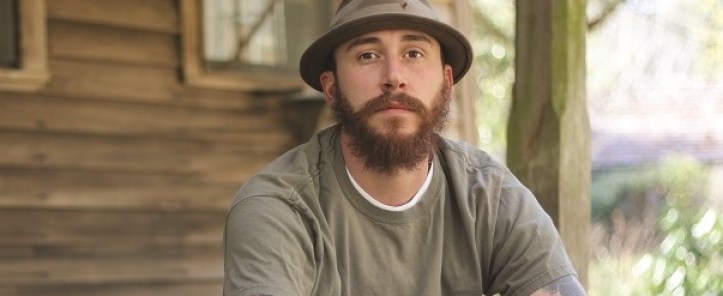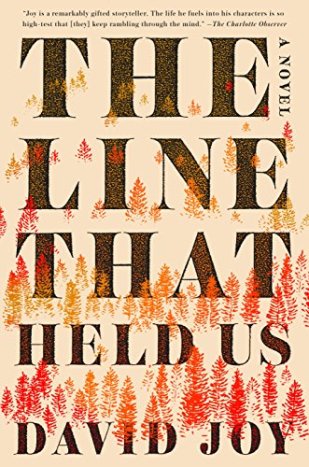
One thing is certain . . . David Joy can really, really write.
Admittedly, I was a little bit on the later side of discovering Joy’s work, but boy, am I glad I did. Someone should pitch Webster’s the idea of adding Joy’s author photo under the definition of “gritty,” because nobody writes quite like he does. His style is dark, yet kind of beautiful, which just saying sounds like an oxymoron. Those who’ve read Joy’s work know exactly what I mean. Those who haven’t, well, you need to.
In the spirit of honesty, The Line That Held Us was actually the first book of his that I ever read. I was interested in it because it was a crime thriller, sounded outdoorsy, and reminded me of other writers I really enjoy like C.J. Box, William Kent Krueger, and Paul Doiron. Turns out, no, those comparisons aren’t exactly spot-on, though of the three I think Joy is most like Doiron, who is much darker than Box and Krueger. As soon as I finished his latest novel, I went back and knocked out his backlist, devouring everything Joy has written. In my opinion, he’s gotten better with each book, with The Line That Held Us my favorite of his so far. Leading up to its publication, I was excited when David Joy agreed to partake in our Five Questions segment, and struggled to cut my long list of questions down to just a handful. In the end, his answers did not disappoint.
Read the full Q&A below, then click here to order your copy of The Line That Held Us, available everywhere tomorrow, Tuesday, August 13th.
TRBS: Wow! What a gritty, well-written, unputdownable crime thriller. . . I absolutely loved The Line That Held Us. How did you come up with the plot idea, and what kind of research did you have to do before actually sitting down to write?
Joy: “I don’t do a lot of research and I don’t plot ahead of time. I tend to start with an image and the characters sort of appear out of that image and I spend a great deal of time thinking about who they are and why they’re there and what they’re trying to tell me. Once I start putting words on the page it’s very much a matter of just sort of following blindly. A lot of times I have absolutely no idea where a story is headed. Now at the same time, that doesn’t always work out and so the real plotting work for me starts once I have a full draft. At that point, I can see a lot of things that I couldn’t see going into the story. I can see the themes. I can start to tell what a book’s about. I can go back and try to strengthen that. I also have a brilliant editor who points things out and I’ve learned to trust her instincts. I don’t always do what she tells me but I damn sure think long and hard about every suggestion she makes. I think she’s probably smarter than I am.
“As far as research, I tend to write about people and places I know. With this book, there was a bit more research than I’ve had to do before because I had a body decomposing and so I had to study that timeline to make sure I got it right. I watched a lot of videos and read a lot of books. I spoke with professors at a nearby university who teach forensic science. At one point I was supposed to go visit a body farm and witness it first hand but that never came together. In the end, the devil’s in the details. As a writer, I think you have to get all the small things right in order to make the reader believe the big lie.”
TRBS: In the book, you reference a 580-pound hog that was hunted outside of Transylvania County. Is that based on a true story?
Joy: “Wild as it is, yes, that’s a true story. The county where I live, Jackson County, borders Transylvania and a few years back there was a father and son who came up to the mountains from Caswell County to hunt hogs on a piece of private property.
“The father was sitting on the ground taking a breather and the son went on ahead of him and got into a laurel thicket. He spooked a passel of hogs out of that thicket and that big boar came out running right at the father. I remember him describing the pig being as big as a buffalo and saying, “When he came out of there, the hair on his back was standing up like he had a mohawk.” The pig got within twenty yards and turned broadside and the father fired. That pig went 707lbs and weighed 580 gutted. They got 150lbs of sausage out of him, and then ham, bacon, tenderloins. I’d say they had breakfast covered for a while.”
TRBS: What is your writing process like? Do you outline your books, have set hours to write, or a target word count you try to hit each day–and what advice do you have for new or aspiring writers?
Joy: “I don’t outline and I certainly don’t write every day. When I was younger I had the privilege of watching Ron Rash work. I think Ron’s one of the most talented writers of my lifetime, but anyways, he was just very methodical. Everything had to be just so when he sat down at the desk, and once everything had its place, he’d work. He wrote every day. His process was clockwork. Every. Single. Day.
“Me, I’ve never been able to do that and so for a long time watching him, I felt inadequate. I felt like I was doing something wrong. Then one day I was reading an old interview in the Paris Review’s Art Of Fiction series, an interview with Raymond Carver. Raymond was talking about how he worked and particularly the times when he wasn’t working and he said, ‘It’s as if I’ve never written a word or had any desire to write.’ That was the feeling I knew. That was what it always felt like when I wasn’t working. But he said that when he was writing it was what John Ashbery called ‘the paddlewheel of days.’ Raymond said it was ‘one day dovetailing into the next.’ He said, ‘Sometimes I don’t even know what day of the week it is.’ When I read that, I felt like he’d captured my process exactly. I remember it just felt empowering. It was validating because here was one of the greatest short story writers to ever live saying he was exactly like me. At the end of Raymond’s response, he said, ‘I’ve learned to be patient and to bide my time. I had to learn that a long time ago. Patience,’ and I think above all else that’s the thing that’s stuck with me.
“I know that if I wait long enough that feeling’s going to come. There’s going to be that compulsion. There’s going to be an image, a character, a story. I trust in that. That’s the one thing that’s never failed me.”
TRBS: You are known for your gritty, up-close-and-personal style, which puts readers shoulder-to-shoulder with the cast of characters. Who, if anyone, are some of the authors that have influenced your writing style, and who are some of your all-time favorite writers?
Joy: “The first time I ever read something and thought, that’s what I want to do, is when Ron Rash handed me a copy of William Gay’s I Hate To See That Evening Sun Go Down. I think William and Larry Brown continue to be the two writers whose work I most identify with. They wrote about the people I know, the people whose stories I want to tell. Daniel Woodrell was another major influence, especially with that first novel I wrote. I was really obsessed with his novels The Death Of Sweet Mister and Tomato Red at the time.
“As far as style, though, I think William’s work is probably what I’m most drawn to. He had a way of blending the brutal and the beautiful. His language made even the most horrific acts of violence palatable. That’s a hard thing to accomplish on the page. Sadly, most the writers I really related to are gone. There’s some new blood trying to fill that gap, but for the most part, it’s falling short. Donald Ray Pollock is really the only person who comes to mind who I think is working at that level. He’s probably my favorite writer at work.”
TRBS: Lastly, what’s next for you?
Joy: “I’m currently working on a novel titled When These Mountains Burn that should be finished by the end of the year. I’m really excited about it. I think it’s probably the best thing I’ve written so far. It’s unlikely that’ll come out next year just because of timing, so maybe sometime in 2020. I’ve also got an anthology I put together and edited to raise money for charity that will come out next spring. It’s called Gather At The River and it’s a collection of fishing essays from some of the top writers in the country. There are some big-name crime writers involved—C.J. Box, J. Todd Scott, Ingrid Thoft, Eric Rickstad, Erik Storey—so you might dig it. All of the royalties from that will go to CAST For Kids, which is a really wonderful organization. I was really happy I pulled that off.”
 From critically acclaimed author David Joy comes a remarkable novel about the cover-up of an accidental death, and the dark consequences that reverberate through the lives of four people who will never be the same again.
From critically acclaimed author David Joy comes a remarkable novel about the cover-up of an accidental death, and the dark consequences that reverberate through the lives of four people who will never be the same again.
When Darl Moody went hunting after a monster buck he’s chased for years, he never expected he’d accidentally shoot a man digging ginseng. Worse yet, he’s killed a Brewer, a family notorious for vengeance and violence. With nowhere to turn, Darl calls on the help of the only man he knows will answer, his best friend, Calvin Hooper. But when Dwayne Brewer comes looking for his missing brother and stumbles onto a blood trail leading straight back to Darl and Calvin, a nightmare of revenge rips apart their world. The Line That Held Us is a story of friendship and family, a tale balanced between destruction and redemption, where the only hope is to hold on tight, clenching to those you love. What will you do for the people who mean the most, and what will you grasp to when all that you have is gone? The only certainty in a place so shredded is that no one will get away unscathed.
Praised as “one of today’s finest book reviewers” by New York Times bestselling author Gayle Lynds, Ryan Steck (“The Godfather of the thriller genre” — Ben Coes) has “quickly established himself as the authority on mysteries and thrillers” (Author A.J. Tata). He currently lives in Southwest Michigan with his wife and their six children.
